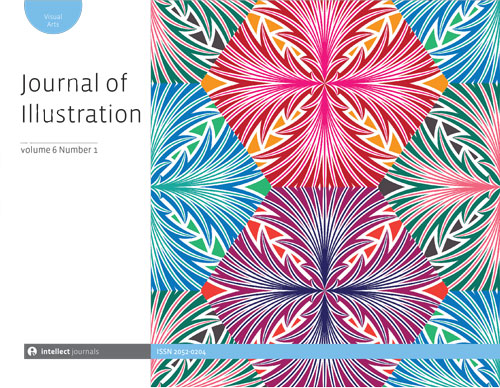Decriminalising Ornament: The Pleasures of Pattern.[1]

This publication is the first of a two-part edition of the International Research Journal, which is an outcome of the international illustration symposium and exhibition ‘Decriminalising Ornament: The Pleasures of Pattern’, held in November 2018 in Anglia Ruskin University in Cambridge. The theme is centred around the same question that was at the heart of the symposium and exhibition, namely the (re)appreciation of ornament and pattern within the context of the field of illustration, but touching upon adjacent disciplines. Until recently, in some quarters of the creative community, the study of Ornament was still held to be regressive, if not reactionary, and echoed the words of Adolf Loos:
“Ornament is no longer a natural product of its culture, and
therefore represents backwardness or even a degenerative tendency.”
— Adolf Loos, Ornament and Crime, 1908
In sympathy with the modernist narrative of form=function, Loos’s seminal essay declared ornament to be a ‘backward’ and ‘degenerate’ activity, counter to the utopian, ‘rationalist’ aims of the modernist movement, and called for it to be criminalized. In response, we invited practitioners and theorist across all disciplines, who wished to bring ornament out of the shadows of function-led Modernism, and to open new and fresh windows onto that which has been seen as superfluous, excessive, and emptied of meaning and purpose by the dominance of the ideologies of Modernist austerity. Traversing both traditional and contemporary creative production/technologies, the papers contained here place the ornamental, the decorative and pattern at the centre, not at the periphery of creative and cultural discourses, as well as displaying respect for and joy in, the making of such of work.[2]
By inviting practitioners and researchers to invade this intellectually policed terrain and to explore the cultural importance of pattern, ornament and decoration, we began from the observation that what is so often missing is the significance – the meaning – of ornament, which has become lost or eroded, but was once all-pervasive. Susan Sontag’s ‘Against Interpretation’ (1964) can be seen as a counter text to Loos. Sontag calls for a greater appreciation of the sensory qualities of the image, and claims that ‘in place of a hermeneutics we need an erotics of art.’[3], while Paul Nash proposes that “we should begin to consider patterns as important as pictures.” (1927). Holding the puritanism of intellectual good taste (formed through Modernist discourses such as Loos’s), in tension with the sensory pleasures of pattern making and ornamental excess, allowed us to explore the resilience, continued value, significance, application, and creation of these cultural forms; celebrating their centrality within human life and cultural production, both past and present, and (speculatively), the future.
As Owen Jones proposed in his seminal 1856 text The Grammar of Ornament, we seek to treat ornament/pattern/decoration as a ‘grammar’. Such a grammar would presuppose a full language in its own right: one whose taxonomy, as seen through the work of the practitioners included here, is posed as the human itself.
Illustration as Decoration
As illustration is rich in decorative elements and often understood as a decorative art-form, these discussions around the decorative should therefore be understood as existential and explore the very nature of illustration itself. There is no denying that the decorative is central to illustration. In its most well-known forms, the published (reproduced) picture, it’s the mark-making of the illustrator, the patterns and textures, the additional elements and ornamentation, that often makes the work distinct. But within illustration, the understanding of the role, expression and interpretation of the decorative form has so far been given little attention. Yet if we are to understand illustration as only visual explanation or visual storytelling, we deny the attention that the illustrator gives to his or her individual signature and expression, as well as a large part of the appreciation of illustration that lies in the distinctiveness and qualities presented through style and detailing.
If we were to see these marks only as meaningful signifiers in service of the story, we would be in danger of forcing false levels of narrative interpretations onto the image, as more often than not, decoration is part of the image for aesthetic reasons. Where we to follow a modernist schema of usefulness, rationality and transparency, we would dismiss embellishment in the name of a systematic functionality but deny the humanising and relational functionalities that are inherent to the decorative and the field of illustration as a whole.
In illustration lines, forms and tones are rarely only functional, but rather, beyond the literal content they present an appreciation of the material, through abundancy and playfulness. This is visible in the individual expression of the illustrator’s marks, but overtly clear in the deliberate application of patterns, textures and ornaments. Though this ornamental quality reveals a creative and engaged human-material link, which has the potential to humanise the image or object, beyond the essential form, it equally represents an excessive use and demand of material and time.
This points to a core dichotomy underlying the ever-shifting position on decoration. Whilst we are going through a period of re-appreciation and re-discovery of ornamentation, in our current climate where social and material abundance is no longer a given, consumption needs to be reeled back and sustainability is seen as essential, signifiers of excess and overt decoration might be seen questionable. How this will affect the zeitgeist, is yet to be seen. But perhaps the lesson of ‘Decriminalising Ornament’, is not to confuse the need for functionality and transparency with the need of humanisation and playfulness when it comes to the appreciation of illustration.
All nine articles in this journal are situated within illustration research and have the decorative at its heart but their approach to the theme represent the broad spectrum of Illustration Research. We have grouped them according to the themes below.
[1] Note: The phrase ‘Decriminalising Ornament. Was coined by Alice Twemlow in her article ‘The Decriminalisation of Ornament’, which was first published in Eye no. 58 vol. 15, Winter 2005. It was reprinted in Looking Closer 5, eds. Beirut, Drenttel and Heller (Allworth Press, 2006).
[2] Note: The editors are grateful to Desdemona McCannon for the following observations: “This puritanical stance towards the decorative can be seen as a historical echo of the protestant Reformation in Europe which conflated decorative imagery in churches with corruption and decadent idolatry; the whitewashing of devotional spaces enacted as a form of moral cleansing. In contrast to this fraught relationship with ornament, the Islamic tradition of non-representational art puts great store in the rhythm and mathematics of pattern to express transcendental truths.”
[3] Note: The editors are grateful to Adrian Holme for the reference to Susan Sontag’s text.



